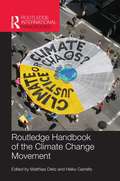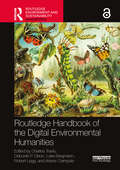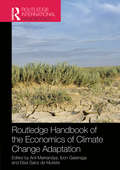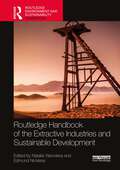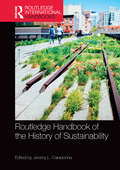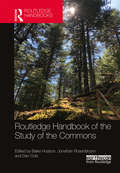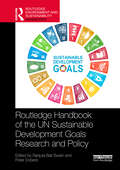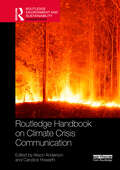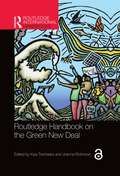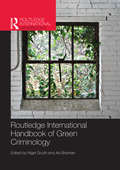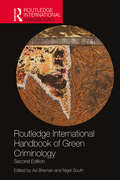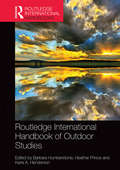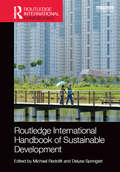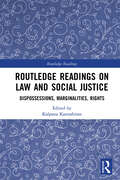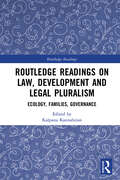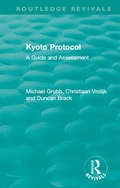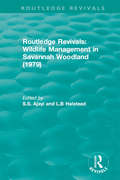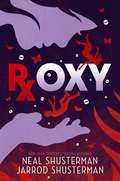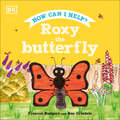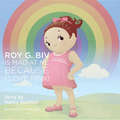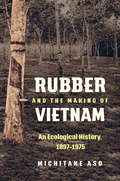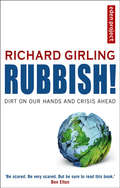- Table View
- List View
Routledge Handbook of the Climate Change Movement (Routledge Environment and Sustainability Handbooks)
by Matthias Dietz Heiko GarreltsThis handbook provides a comprehensive overview of the growing transnational climate movement. A dual focus on climate politics and civil society provides a hitherto unavailable broad and systematic analysis of the current global movement, highlighting how its dynamic and diverse character can play an important role in environmental politics and climate protection. The range of contributors, from well-known academics to activist-scholars, look at climate movements in the developed and developing world, north and south, small and large, central and marginal. The movement is examined as a whole and as single actors, thereby capturing its scope, structure, development, activities and influence. The book thoroughly addresses theoretical approaches, from classic social movement theory to the influence of environmental justice frames, and follows this with a systematic focus on regions, specific NGOs and activists, cases and strategies, as well as relations with peripheral groups. In its breadth, balance and depth, this accessible volume offers a fresh and important take on the question of social mobilization around climate change, making it an essential text for advanced undergraduates, postgraduate students and researchers in the social sciences.
Routledge Handbook of the Digital Environmental Humanities (Routledge Environment and Sustainability Handbooks)
by Luke Bergmann Charles Travis Deborah P. Dixon Robert Legg Arlene CrampsieThe Routledge Handbook of the Digital Environmental Humanities explores the digital methods and tools scholars use to observe, interpret, and manage nature in several different academic fields. Employing historical, philosophical, linguistic, literary, and cultural lenses, this handbook explores how the digital environmental humanities (DEH), as an emerging field, recognises its convergence with the environmental humanities. As such, it is empirically, critically, and ethically engaged in exploring digitally mediated, visualised, and parsed framings of past, present, and future environments, landscapes, and cultures. Currently, humanities, geographical, cartographical, informatic, and computing disciplines are finding a common space in the DEH and are bringing the use of digital applications, coding, and software into league with literary and cultural studies and the visual, film, and performing arts. In doing so, the DEH facilitates transdisciplinary encounters between fields as diverse as human cognition, gaming, bioinformatics and linguistics, social media, literature and history, music, painting, philology, philosophy, and the earth and environmental sciences. This handbook will be essential reading for those interested in the use of digital tools in the study of the environment from a wide range of disciplines and for those working in the environmental humanities more generally.
Routledge Handbook of the Economics of Climate Change Adaptation: Routledge Handbook Of The Economics Of Climate Change Adaptation (Routledge International Handbooks)
by Ibon Galarraga Anil Markandya Elisa Sainz de MurietaClimate change is one of the greatest challenges facing human kind owing to the great uncertainty regarding future impacts, which affect all regions and many ecosystems. Many publications deal with economic issues relating to mitigation policies, but the economics of adaptation to climate change has received comparatively little attention. However, this area is is critical and a central pillar of any adaptation strategy or plan and is the economic dimension, which therefore merits the increase in attention it is receiving. This book deals with the difficulties that face the economics of adaptation. Critical issues include: uncertainty; baselines; reversibility, flexibility and adaptive management; distributional impacts; discount rates and time horizons; mixing monetary and non-monetary evaluations and limits to the use of cost-benefit analysis; economy-wide impacts and cross-sectoral linkages. All of these are addressed in the book from the perspective of economics of adaptation. Other dimensions of adaptation are also included, such as the role of low- and middle-income countries, technology and the impacts of extreme events. This timely book will prove essential reading for international researchers and policy makers in the fields of natural resources, environmental economics and climate change.
Routledge Handbook of the Extractive Industries and Sustainable Development (Routledge Environment and Sustainability Handbooks)
by Natalia YakovlevaThe Routledge Handbook of the Extractive Industries and Sustainable Development provides a cutting-edge, comprehensive overview of current trends, challenges and opportunities for metal and mineral production and use, in the context of climate change and the United Nations Sustainable Development Agenda 2030. Minerals and metals are used throughout the world in manufacturing, construction, infrastructure, production of electronics and consumer goods. Alongside this widespread use, extraction and processing of mineral resources take place in almost every nation at varying scales, both in developing countries and major developed nations. The chapters in this interdisciplinary handbook examine the international governance mechanisms regulating social, environmental and economic implications of mineral resource extraction and use. The original contributions, from a range of scholars, examine the relevance of the mining industry to the United Nations Sustainable Development Goals (SDGs), reviewing important themes such as local communities Indigenous peoples, gender equality and fair trade, showing how mining can influence global sustainable development. The chapters are organised into three sections: Global Trends in Mineral Resources Consumption and Production; Technology, Minerals and Sustainable Development; and Management of Social, Environmental and Economic Issues in the Mining Industry. This handbook will serve as an important resource for students and researchers of geology, geography, earth science, environmental studies, engineering, international development, sustainable development and business management, among others. It will also be of interest to professionals in governmental, international and non-governmental organisations that are working on issues of resource governance, environmental protection and social justice.
Routledge Handbook of the History of Sustainability (Routledge Environment and Sustainability Handbooks)
by Jeremy L. CaradonnaThe Routledge Handbook of the History of Sustainability is a far-reaching survey of the deep and contemporary history of sustainability. This innovative resource will help to define the history of sustainability as an identifiable field. It provides a unique resource for advanced undergraduates, graduate students, and scholars, and delivers essential context for understanding the current state and future path of the sustainability movement. The history of sustainability is an increasingly important domain within the discipline of history, which draws on an interdisciplinary set of fields, ranging from energy studies, transportation, and urbanism to environmental history, economics, and philosophy. Key sections in this handbook cover the historiography of sustainability, resilience and collapse in historical societies, the deep roots of sustainability (seventeenth century to nineteenth century), the recent history of sustainability (twentieth century to present), and core issues and key debates in sustainability. This handbook is an invaluable research and teaching tool for those interested in the history and development of sustainability and an essential resource for the many sustainability studies programs that now exist in the world's universities.
Routledge Handbook of the Study of the Commons
by Blake Hudson Jonathan Rosenbloom Dan ColeThe "commons" has come to mean many things to many people, and the term is often used inconsistently. The study of the commons has expanded dramatically since Garrett Hardin’s The Tragedy of the Commons (1968) popularized the dilemma faced by users of common pool resources. This comprehensive Handbook serves as a unique synthesis and resource for understanding how analytical frameworks developed within the literature assist in understanding the nature and management of commons resources. Such frameworks include those related to Institutional Analysis and Development, Social-Ecological Systems, and Polycentricity, among others. The book aggregates and analyses these frameworks to lay a foundation for exploring how they apply according to scholars across a wide range of disciplines. It includes an exploration of the unique problems arising in different disciplines of commons study, including natural resources (forests, oceans, water, energy, ecosystems, etc), economics, law, governance, the humanities, and intellectual property. It shows how the analytical frameworks discussed early in the book facilitate interdisciplinarity within commons scholarship. This interdisciplinary approach within the context of analytical frameworks helps facilitate a more complete understanding of the similarities and differences faced by commons resource users and managers, the usefulness of the commons lens as an analytical tool for studying resource management problems, and the best mechanisms by which to formulate policies aimed at addressing such problems.
Routledge Handbook of the UN Sustainable Development Goals Research and Policy (Routledge Environment and Sustainability Handbooks)
by Ranjula Bali Swain Peter DobersThis handbook brings together a collection of seminal research on the Sustainable Development Goals (SDGs) and investigates the effectiveness of the 17 goals for achieving transformative change toward sustainable development. As a collection of inter- and transdisciplinary research from around the world, this volume explores the applications, implications, and best practices of the goals at thematic, regional, and national levels, providing specific examples from a diverse range of places, such as Australia, Brazil, China, DRC, India, Italy, the Sahel region of Africa, and the USA, among others. The book serves as a mid-term evaluation of the SDGs, bringing to the fore comprehensive experiences and evidence related to the SDGs, whilst highlighting the interlinkages between the different goals. The handbook is divided into two parts: Part I brings together groundbreaking research to define, identify, and present conceptual frameworks for a sustainable future, whilst Part II focuses on the policies, practices, and implementation of the SDGs. The chapters identify key aspects missing from the 2030 Agenda, such as global power imbalances, cultural diversity, Indigenous rights, and unsustainable levels of consumption; they also critically evaluate the overall delivery and effectiveness of the SDGs whilst outlining potential future directions for the post-SDG 2030 Agenda. This handbook is aimed at a diverse and global audience of academics and students of economics, business studies, political science, and development studies. It will also serve as a valuable reference for leaders in the industry, the public sector, civil society, and international policymakers keen to gain a better understanding of the SDGs.
Routledge Handbook on Climate Crisis Communication (Routledge Environment and Sustainability Handbooks)
by Alison Anderson Candice HowarthThis Handbook provides a state-of-the-art review of leading research on climate change communication. As climate change has moved further up the political agenda, the challenge of how to communicate the scientific, social, and political aspects of the climate emergency is of increasing interest to researchers, NGOs, governments, and policymakers at national and international levels. The Routledge Handbook on Climate Crisis Communication provides a concise and expert summary of this growing field, explaining the theoretical, conceptual, and empirical developments that have been made in recent years and describing the origins and connections to broader topics, including risk perception; environmental journalism; social media; and climate justice and activism. With contributions from leading international scholars, the book is divided into seven key parts, besides the Introduction chapter:Part One: Conceptual ChallengesPart Two: Methodological ConsiderationsPart Three: Communicating Climate Science across CulturesPart Four: Journalism and News ReportagePart Five: Activism and Social MovementsPart Six: Audiences and Popular CulturePart Seven: Future DirectionsTaking stock of the current landscape of climate change communication and helping to shape the field of inquiry going forward, this is a go-to guide for established and newly interested researchers, government and policymaking bodies, and students and their instructors.
Routledge Handbook on the Green New Deal (Routledge International Handbooks)
by Kyla Tienhaara Joanna RobinsonIn recent years, the Green New Deal has moved from relative obscurity to front and centre of policy discussions and public debates about how to respond to the climate crisis. It has been credited with radically changing the nature of the conversation on climate change and with re-energizing the environmental movement at a critical time. All Green New Deal proposals share an emphasis on the need for governments (rather than markets) to lead the energy transition. However, they differ in other respects. This Handbook analyses the fundamentals underlying all Green New Deals as well as exploring national and regional variations. It is divided into three parts. The first part examines the political economy of the Green New Deal focussing not just on how proposals will be costed but also on opportunities for a fundamental transformation of both national economies and the global economic system. The second part explores issues of justice, which are central to many Green New Deal proposals, including Indigenous rights, racial and gender equity, and justice for the Global South. In the third part, authors detail case studies of Green New Deal proposals and plans at the local, national, and regional level. This book will be an invaluable research and reference volume for students and scholars in economics, politics, sociology, geography, and environmental studies. It should also be of interest to those actively involved in climate and environmental policymaking.
Routledge International Handbook of Green Criminology (Routledge International Handbooks)
by Avi Brisman Nigel SouthAcademic and general interest in environmental crimes, harms, and threats, as well as in environmental legislation and regulation, has grown sharply in recent years. The Routledge International Handbook of Green Criminology is the most in-depth and comprehensive volume on these issues to date. With contributions from leading international green criminologists and scholars in related fields, the Handbook examines a wide range of substantive issues, including: climate change corporate criminality and impacts on the environment environmental justice media representations pollution (e.g. air, water) questions of responsibility and risk wildlife trafficking The chapters explore green criminology in depth, its theory, history and development, as well as methodological concerns for this area of academic interest. With examples of environmental crimes, harms, and threats from Africa, Asia, Australia, Eastern Europe, South America, the United Kingdom, and the United States, this book will serve as a vital resource for international scholars and students in criminology, sociology, law and socio-legal studies, as well as environmental science, environmental studies, politics and international relations.
Routledge International Handbook of Green Criminology (Routledge International Handbooks)
by Avi BrismanThe Routledge International Handbook of Green Criminology was the first comprehensive and international anthology dedicated to green criminology. It presented green criminology to an international audience, described the state of the field, offered a description of a range of environmental issues of regional and global importance, and argued for continued criminological attention to environmental crimes and harms, setting an agenda for further study. In the six years since its publication, the field has continued to grow and thrive. This revised and expanded second edition of the Handbook reflects new methodological orientations, new locations of study such as Asia, Canada and South America, and new responses to environmental harms. While a number of the original chapters have been revised, the second edition offers a range of fresh chapters covering new and emerging areas of study, such as: conservation criminology, eco-feminism, environmental victimology, fracking, migration and eco-rights, and e-waste. This handbook continues to define and capture the field of green criminology and is essential reading for students and researchers engaged in green crime and environmental harm.
Routledge International Handbook of Outdoor Studies (Routledge Advances in Outdoor Studies)
by Barbara Humberstone Karla A. Henderson Heather PrinceThe 'outdoors' is a physical and ideological space in which people engage with their environment, but it is also an important vehicle for learning and for leisure. The Routledge Handbook of Outdoor Studies is the first book to attempt to define and survey the multi-disciplinary set of approaches that constitute the broad field of outdoor studies, including outdoor recreation, outdoor education, adventure education, environmental studies, physical culture studies and leisure studies. It reflects upon the often haphazard development of outdoor studies as a discipline, critically assesses current knowledge in outdoor studies, and identifies further opportunities for future research in this area. With a broader sweep than any other book yet published on the topic, this handbook traces the philosophical and conceptual contours of the discipline, as well as exploring key contemporary topics and debates, and identifying important issues in education and professional practice. It examines the cultural, social and political contexts in which people experience the outdoors, including perspectives on outdoor studies from a wide range of countries, providing the perfect foundation for any student, researcher, educator or outdoors practitioner looking to deepen their professional knowledge of the outdoors and our engagement with the world around us.
Routledge International Handbook of Sustainable Development (Routledge International Handbooks)
by Michael Redclift Delyse SpringettThis Handbook gives a comprehensive, international and cutting-edge overview of Sustainable Development. It integrates the key imperatives of sustainable development, namely institutional, environmental, social and economic, and calls for greater participation, social cohesion, justice and democracy as well as limited throughput of materials and energy. The nature of sustainable development and the book’s theorization of the concept underline the need for interdisciplinarity in the discourse as exemplified in each chapter of this volume. The Handbook employs a critical framework that problematises the concept of sustainable development and the struggle between discursivity and control that has characterised the debate. It provides original contributions from international experts coming from a variety of disciplines and regions, including the Global South. Comprehensive in scope, it covers, amongst other areas: Sustainable architecture and design Biodiversity Sustainable business Climate change Conservation Sustainable consumption De-growth Disaster management Eco-system services Education Environmental justice Food and sustainable development Governance Gender Health Indicators for sustainable development Indigenous perspectives Urban transport The Handbook offers researchers and students in the field of sustainable development invaluable insights into a contested concept and the alternative worldviews that it has fostered.
Routledge Readings on Law and Social Justice: Dispossessions, Marginalities, Rights (Routledge Readings)
by Kalpana KannabiranRoutledge Readings on Law and Social Justice: Dispossessions, Marginalities, Rights presents some of the finest essays on social justice, rights and public policy. With a lucid new Introduction, it covers a vast range of issues and offers a compelling guide to understanding law and socio- legal studies in South Asia. The book covers critical themes such as the jurisprudence of rights, justice, dignity, with a focus on the regimes of patriarchy, labour and dispossession. The fourteen chapters in the volume, divided into three sections, examine contested sites of the constitution, courts, prisons, land and complex processes of migration, trafficking, digital technology regimes, geographical indications and their entanglements. This multidisciplinary volume foregrounds the politics and plural lives of/ in law by including perspectives from major authors who have contributed to the academic and/ or policy discourse of the subject. This book will be useful to students, scholars, policymakers and practitioners interested in a nuanced understanding of law, especially those studying law, marginality and violence. It will serve as essential reading for those in law, socio- legal studies, legal history, South Asian studies, human rights, jurisprudence and constitutional studies, gender studies, history, politics, conflict and peace studies, sociology and social anthropology. It will also appeal to legal historians and practitioners of law, and those in public administration, development studies, environmental studies, migration studies, cultural studies, labour studies and economics.
Routledge Readings on Law, Development and Legal Pluralism: Ecology, Families, Governance (Routledge Readings)
by Kalpana KannabiranRoutledge Readings on Law, Development and Legal Pluralism presents some of the finest essays on social justice, environment, rights and governance. With a lucid new Introduction, it covers a vast range of issues and offers a compelling guide to understanding the harm and risk relating to biodiversity, agro-ecology, disaster, and forest rights. The book covers critical themes such as ecology, families and governance and establishes the trajectory of contemporary ecology and law in South Asia. The thirteen chapters in the volume, divided into three sections, trace violence and marginality in the plurality of families and their laws in India, as well as discuss community-based just practices. With debates on development, governance and families, the book highlights the politics and practices of law making, law reform and law application. This multi-disciplinary volume foregrounds the politics and plural lives of/in law by including perspectives from major authors who have contributed to the academic and/or policy discourse of the subject. This book will be useful to students, scholars, policymakers, practitioners and the general reader interested in a nuanced understanding of law, especially those studying law, marginality, kinship and indigeneity studies. It will serve as essential reading for those in law, socio-legal studies, environment studies and ecology, social exclusion studies, development studies, South Asian studies, human rights, jurisprudence and constitutional studies, gender studies, history, politics, conflict and peace studies, sociology and social anthropology. It will also appeal to legal historians and practitioners of law, environmentalists, and those in public administration.
Routledge Revivals: A Guide and Assessment (Routledge Revivals)
by Michael Grubb Duncan Brack Christiaan VrolijkOriginally published in 1999, The Kyoto Protocol provides a detailed discussion on the history, terms and implications of the Kyoto Protocol 1997. It explains the meaning of provision on emissions trading and other flexibility mechanisms, and provides a quantitative analysis using the Energy and Environment Programme's emissions trading model. It also contains the full text of the Kyoto Protocol and developments at the 4th Conference of the Parties in December 1998. This book will be of interest to academics working in the field of climate change, as well as the broader area of environment and sustainability.
Routledge Revivals: Wildlife Management in Savannah Woodland (Routledge Revivals)
by S.S. Ajayi and L.B. HalsteadOriginally published in 1979, Wildlife Management in Savannah Woodland provides a multidisciplinary approach to the environment. Developed by local scientists with a deep knowledge and understanding of the local situation, the book provides a pragmatic and realistic approach to West African conditions.
Rover Throws a Party: Inspired by NASA's Curiosity on Mars
by Kristin L. GrayInspired by NASA's Curiosity rover, this is the story of a lonely Mars rover who plans the best birthday party in the solar system.It's Rover's anniversary on Mars! Time to celebrate by throwing the best party this planet has ever seen. Rover hands out invitations all over town, but it seems like he's the only one around. Will anyone come to the party, or will Rover be all alone on his big day? In 2013, NASA programmed their Curiosity rover to hum "Happy Birthday to You" in honor of its first year on Mars. Inspired by this anecdote, this is the tale of a lonely rover and his party, accompanied by fascinating Mars rover facts that help explain the real science behind the story. This fun birthday tale provides an accessible, kid-friendly look at one of NASA's coolest programs.
Roxy
by Neal Shusterman Jarrod ShustermanFrom the team that brought you the New York Times bestselling Dry comes a &“gritty and unflinching&” (Booklist) thriller that proves when gods play games, even love is a lie.The freeway is coming. It will cut the neighborhood in two. Construction has already started, pushing toward this corridor of condemned houses and cracked concrete with the momentum of the inevitable. Yet there you are, in the fifth house on the left, fighting for your life. Ramey, I. The victim of the bet between two manufactured gods: the seductive and lethal Roxy (Oxycontin), who is at the top of her game, and the smart, high-achieving Addison (Adderall), who is tired of being the helpful one, and longs for a more dangerous, less wholesome image. The wager—a contest to see who can bring their mark to &“the Party&” first—is a race to the bottom of a rave that has raged since the beginning of time. And you are only human, dazzled by the lights and music. Drawn by what the drugs offer—tempted to take that step past helpful to harmful…and the troubled places that lie beyond. But there are two I. Rameys—Isaac, a soccer player thrown into Roxy&’s orbit by a bad fall and a bad doctor and Ivy, his older sister, whose increasing frustration with her untreated ADHD leads her to renew her acquaintance with Addy. Which one are you?
Roxy the Butterfly (Roly and Friends)
by Frances RodgersA delightful picture book that informs young readers of how they can help the butterflies that like to visit their backyard Step outside and find out about how you can help the adorable animals that like to visit your garden. Little ones will love following Roxy the Butterfly as she sets off burrowing around your backyard garden, finding wonderfully colorful flowers to feed on and a cozy bug hotel to rest in after a long, hard day of exploring. But with bumps along the way, she&’ll need your help, will you volunteer as her little helper? This sweet picture book gently introduces young readers to the idea of animal conservation and protection. Bursting with fun trivia, little ones will learn how unique butterflies are, and what makes them worth preserving. There are plenty of tips and tricks on how we can care for garden-dwelling friends like Roxy to keep them safe from the dangers they may face. No one is too young to start making a difference. Roxy the Butterfly is the perfect gift for any small-animal lover, or budding environmentalist, and will inspire toddlers to discover what is unseen in their gardens.
Roy G. Biv Is Mad at Me Because I Love Pink!
by Nancy Guettier&“A cute story that teaches the colors of the rainbow&” from the author of Mermaids on Mars and Circus in the Sky (The Naptime Reviewer). Roy G. Biv Is Mad at Me Because I Love Pink! is an educational and playful story about learning of the colors of the rainbow. Roy G. Biv is an acronym for the sequence of the hues in the rainbow: Red, Orange, Yellow, Green, Blue, Indigo, Violet. &“Singer-songwriter and children&’s book author Nancy Guettier finds inspiration in each of her kids to write entertaining children&’s stories. Guettier&’s style is whimsical and fun, making learning effortless . . . Roy G. Biv Is Mad at Me Because I Love Pink! is centered around Genevieve who loves splashing in puddles after a rain shower. Mostly, Genevieve loves pink; however, pink is not a color in the rainbow. Understandably that upsets Roy G. Biv, who convinces her to experience all the colors of the rainbow.&” —MySocialGoodNews.com &“Your children will dive in to Genevieve&’s adventure with Roy G. Biv, as he tries to show her that pink is a fine color but she should try other ones as well. Your toddler will learn so much about colors and will be able to associate them with colorful objects they may encounter in their everyday routine.&” —TheBabySpot.ca
Rubber Boots Methods for the Anthropocene: Doing Fieldwork in Multispecies Worlds
by Nils Bubandt Astrid Oberborbeck Andersen Rachel CypherA methodological follow-up to Arts of Living on a Damaged Planet The environmental and climatic crises of our time are fundamentally multispecies crises. And the Anthropocene, a time of &“human-made&” disruptions on a planetary scale, is a disruption of the fabric of life as a whole. The contributors to Rubber Boots Methods for the Anthropocene argue that understanding the multispecies nature of these disruptions requires multispecies methods.Answering methodological challenges posed by the Anthropocene, Rubber Boots Methods for the Anthropocene retools the empirical study of the socioecological chaos of the contemporary moment across the arts, human science, and natural science. Based on critical landscape history, multispecies curiosity, and collaboration across disciplines and knowledge systems, the volume presents thirteen transdisciplinary accounts of practical methodological experimentation, highlighting diverse settings ranging from the High Arctic to the deserts of southern Africa and from the pampas of Argentina to the coral reefs of the Western Pacific, always insisting on the importance of firsthand, &“rubber boots&” immersion in the field.The methodological companion to Arts of Living on a Damaged Planet: Ghosts and Monsters of the Anthropocene (Minnesota, 2017), this collection puts forth empirical studies of the multispecies messiness of contemporary life that investigate some of the critical questions of our time.Contributors: Filippo Bertoni, Museum für Naturkunde, Berlin; Harshavardhan Bhat, U of Westminster; Nathalia Brichet, U of Copenhagen; Janne Flora, Aarhus U, Denmark; Natalie Forssman, U of British Columbia; Peter Funch, Aarhus U; Kirsten Hastrup, U of Copenhagen; Colin Hoag, Smith College; Joseph Klein, U of California, Santa Cruz; Andrew S. Mathews, U of California, Santa Cruz; Daniel Münster, U of Oslo; Ursula Münster, U of Oslo; Jon Rasmus Nyquist, U of Oslo; Katy Overstreet, U of Copenhagen; Pierre du Plessis, U of Oslo; Meredith Root-Bernstein; Heather Anne Swanson, Aarhus U; Anna Lowenhaupt Tsing, U of California,Santa Cruz; Stine Vestbo.
Rubber and the Making of Vietnam: An Ecological History, 1897–1975 (Flows, Migrations, and Exchanges)
by Michitake AsoDating back to the nineteenth-century transplantation of a latex-producing tree from the Amazon to Southeast Asia, rubber production has wrought monumental changes worldwide. During a turbulent Vietnamese past, rubber transcended capitalism and socialism, colonization and decolonization, becoming a key commodity around which life and history have revolved. In this pathbreaking study, Michitake Aso narrates how rubber plantations came to dominate the material and symbolic landscape of Vietnam and its neighbors, structuring the region's environment of conflict and violence. Tracing the stories of agronomists, medical doctors, laborers, and leaders of independence movements, Aso demonstrates how postcolonial socialist visions of agriculture and medicine were informed by their colonial and capitalist predecessors in important ways. As rubber cultivation funded infrastructural improvements and the creation of a skilled labor force, private and state-run plantations became landscapes of oppression, resistance, and modernity.Synthesizing archival material in English, French, and Vietnamese, Aso uses rubber plantations as a lens to examine the entanglements of nature, culture, and politics and demonstrates how the demand for rubber has impacted nearly a century of war and, at best, uneasy peace in Vietnam.
Rubbish!: Dirt On Our Hands And Crisis Ahead
by Richard GirlingWe can no longer cope with our waste. Every hour in the UK we throw away enough rubbish to fill the Albert hall - a statistic quoted so often that perhaps we've stopped imagining what it means. And every year the flow accelerates.This is the story of our rubbish - from the first human bowel movement to the littering of outer space. With a hankerchief to his nose, Girling picks through our fridge mountain, our crumbling sewers, trading waste, packaging waste, hazardous industrial waste... it is a mucky saga of carelessness, greed and opportunism, wasted opportunity and official bungling. But Rubbish! is also a plea for us to consider other kinds of waste: the trashing of our landscape, the unstoppable floods of junk that clog our mailboxes, litter the skies and foul the airwaves...Rubbish! may not be a conventional battle cry but this is unmistakably a call to arms - not just for the three 'R's - reduce, re-use, recycle - but for us to fight for new ideas, brave initiative rather than reliance on old systems that are crumbling before our eyes.
Rubies, Diamond and Garnets, Too ...: A Sparkling Block-of-the-Month Quilt
by Bernadette KentThe breathtaking sparkle of diamonds and the deep, dramatic reds of rubies and garnets have bewitched us for centuries. They conjure visions of luxury, wealth and beauty. Through time, we’ve used them as tokens of our love and esteem for those we cherish. Translate those same jewel tones into fabric and you have the makings for an electrifying quilt that, much like a perfect gem, will be handed down for generations. The quilt was used as The Kansas City Star’s Block-of-the-Month program and highlights 13 block designs. A second version uses the same patterns but gives you the opportunity to make a much larger quilt by adding two more large blocks and 12 smaller blocks.
